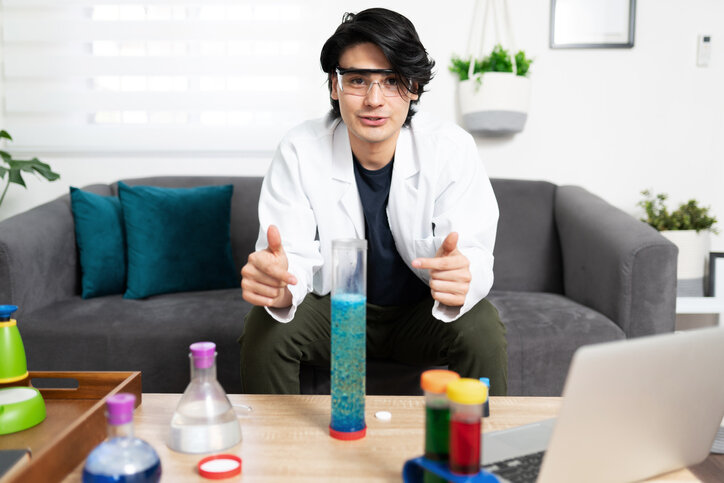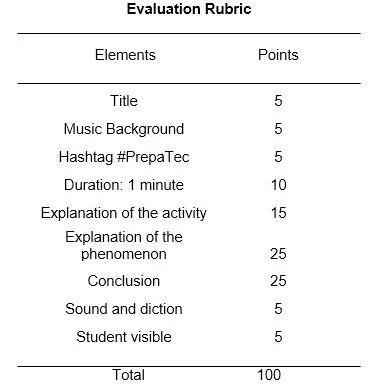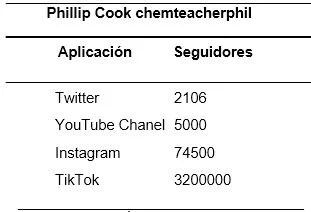“TikTok is a tool that has great potential to be used in the classroom in any area of knowledge.”
High school students usually do not like chemistry classes because they feel it is not a subject they will practice in their professional careers. Given this lack of interest, we chemistry teachers must look for strategies to motivate students to learn this highly relevant knowledge in their daily lives. One way could be to awaken their curiosity about the phenomena occurring around them, for example, the rising of a baking cake, the action of mosquito repellents, the whitening of clothes from bleach, the combustion of gasoline, the disinfecting of a wound, the natural fermentation of food – the list is infinite.
The pandemic forced us to migrate face-to-face classes to virtual classes. We had to adapt the formats of chemistry classes, content, and laboratory practices to a virtual environment. We thought of activities that would stimulate students’ interest and, given the circumstances of the COVID-19 contingency, put their technological skills into practice in a fun way. According to a survey applied by professor María del Pilar Ponce Cincire during the pandemic, 98.7% of students prefer to do experiments at home rather than use an online laboratory or simulator.
“The students were able to explain the experiment, the result, and the conclusion in a one-minute video; this helped them to develop critical thinking and metacognition.”
Chemistry lab practices on TikTok
I taught Inorganic Chemistry at the Prepa Tec Campus Morelia for third-semester students in August-December 2020. We had 129 students between the ages of 16 and 17. Due to the pandemic, we had to adapt the course to the Flexible Digital Model that guides the didactics of Tecnologico de Monterrey. We used Zoom for video conferencing and redesigned synchronous and asynchronous activities for the best class advantage. The course was planned to explain the key concepts and reinforce the students’ learning during the synchronous sessions. During the asynchronous sessions, the students develop competencies through research and weekly activities to relate the topics seen in class with real applications.
Chemistry classes in a face-to-face format are complemented by laboratory practices for which students submit a written report of their observations, results, and conclusions. Due to the pandemic, this was not possible, so we decided to carry the experiments into the home. We designed two fun activities in which students had to show a chemical phenomenon. Instead of producing a written report, they were asked to make a one-minute video presentation using TikTok to explain the phenomena observed in the experiments and their conclusions.
The project’s main objectives were to motivate students to learn about inorganic chemistry with innovative activities, develop their self-management skills, and use technology in chemistry class. The laboratory activities designed were as follows:
-
Intermolecular forces. It is an experiment about surface tension, a force that can prevent water from spilling out of an open jar when it is turned upside down. It is like a “magic trick” that a magician would include in his repertoire.
-
Hot ice from baking soda. This experiment mixes baking soda and vinegar to make sodium acetate, known as hot ice. Hot ice is an unusual reaction because although it looks like ice or snow, it is not. In reality, it is an oversaturated suspension that crystallizes at room temperature.
To evaluate the TikTok videos made by the students, we used the following rubric, although it can be adapted to the needs of other classes:
Image 2: Evaluation rubric for the TikTok videos made by the students.
Activity Design
We asked the students: Which social media do you like to use the most to design this activity? Instagram was first with over 51.9% preference, followed by TikTok with 14.7% (see Image 3).
Image 3: Students’ social media preferences.
Although the students preferred the Instagram app, the downside is that video stories posted on Instagram are available only 24 hours. On the other hand, the TikTok app allows making a one-minute custom video, sharing it with friends, and downloading it in mp4 format to use on other platforms. Some essential facts about TikTok are that it attained more than 2 billion downloads in April 2020, 41% of its users are between the ages of 16 and 24, and 90% of TikTok users say they use the app daily.
To carry out this activity, we were inspired by the scientist and professor of chemistry, Dr. Phillip Cook @chemteacherphil. He created a channel on TikTok with videos of tutorial-style educational experiments for chemistry with over 3.2 million followers. He also has other chemistry experiment channels (see image 4); however, TikTok is the most attractive medium for his followers).
Image 4: Followers of scientist Phillip Cook on different applications.
Evaluation of results
The satisfaction survey applied to 129 students at the end of the August-December 2020 semester contained the question, “Did you like the new chemistry labs format using the TikTok Act app?” On a Likert scale from 1 to 5, where five is very satisfactory and one unsatisfactory, the average score was 4.76 with a standard deviation of 0.28. The primary purpose had been to get students to learn inorganic chemistry through innovative activities that motivated them. On this occasion, we did not analyze any improvement in academic performance when delivering the lab activity report using TikTok; however, it is essential to do so with further research.
The students commented that they had a lot of fun doing the experiments at home and getting the reagents. They also mentioned that the experiment did go well for them at first and that they had to repeat it several times before recording the video. However, this allowed them to develop their patience and, in turn, try different ways to experiment with better results.
At the end of the activity, we could see that the students used a lot of imagination and creativity to make their videos. They combined the TikTok application with other video editing tools like iMovie, InShot, Adobe® Premiere Rush, and Magisto, among others, before uploading the final video to TikTok. The students could explain the experiment, results, and conclusion in a one-minute video while enjoying the process. It helped them develop critical thinking and improve metacognition. I believe that TikTok is a tool with great potential to be used in the classroom in any area of knowledge.
About the author
Arlette Audiffred Hinojosa (arlette.audiffred@itesm.mx) is a professor in the multicultural program of Prepa Tec Campus Morelia. She teaches Chemistry and Social Entrepreneurship and collaborates in educational innovation projects at Tecnologico de Monterrey.
References
Pantoja, F. (2020). Using TikTok in the classroom to manage emotions. Observatorio de Innovación educativa. Accessed May 10, 2021 at: https://observatorio.tec.mx/edu-bits-blog/tiktok-en-el-aula-manejo-de-emociones
Phillip Cook (E@chemteacherphil). Official TikTok | Watch Phillip Cook. Accessed May 13, 2021, at: https://www.tiktok.com/@chemteacherphil?lang=en
Ponce_Cincire (2021, January 22). The Science Lab at Home. Observatorio de Innovación Educativa. Accessed May 13, 2021 at https://observatorio.tec.mx/edu-bits-blog/el-laboratorio-de-ciencias-en-casa
ModeloTec21(2020). Tecnológico de Monterrey. Accessed May 11, 2021 at:
MDF. Modelo Flexible y Digital (2020) – Innovación Educativa, Tecnológico de Monterrey.
Accessed May 11, 2021, at: https://innovacioneducativa.tec.mx/transforma-flexible-draft/modelo-flexible-digital
Observatorio de Innovación Educativa. Get to Know the Flexible Digital Model of Tecnologico de Monterrey. Accessed May 12, 2021, at: https://observatorio.tec.mx/edu-news/modelo-flexible-digital-tec-de-monterrey
Edited by Rubí Román (rubi.roman@tec.mx) – Observatory of Educational Innovation.
Translation by Daniel Wetta.
This article from Observatory of the Institute for the Future of Education may be shared under the terms of the license CC BY-NC-SA 4.0 
)
)




)